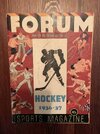For any ATD’ers interested in a little side quest…
As I wrote earlier in the Draft Thread today, I am currently working on a new book about the NHL’s First Expansion Era from 1924-1942. It’s perhaps my favourite period when researching old players, and I’m particularly fond on the New York Americans and Montreal Maroons franchises. This book is proving to be a massive undertaking and so, I would love the help of anyone that is interested in being apart of this project.
I’ve already been conducting countless interviews with various players of this era’s families, and done piles upon piles of research, acquiring old documents, photos, etc.
The book is going to run a season-by-season recap from 1924-1942, with a focus on some of the major hockey stories of that season. Below is a sample of stories for some of the seasons that I’m working with, so if anyone has any interesting stories they’d like added, please fill in the blanks or add it to the list.
1924-25 – Boston/Maroons expansion. The story of the end of the Hamilton Tigers
1925-26 – New York Americans and Pittsburgh Pirates join/Maroons defeat Victoria for Cup. The death of Georges Vezina.
1926-27 – Ottawa’s last Stanley Cup.
1927-28 – Lester Patrick plays goalie in Stanley Cup final
1928-29 – The Kid Line (Conacher, Primeau, Jackson)
1929-30 – Clint Benedict mask and history in Ottawa, trade to Maroons.
1930-31 –
1931-32 –
1932-33 –
1933-34 – Eddie Shore and Ace Bailey incident and first NHL All Star Game/Death of Charlie Gardiner
1934-35 – Montreal Maroons’ Stanley Cup
1935-36 – Longest NHL game, Mud Bruneteau
1936-37 – Howie Morenz Death
1937-38 – Montreal Canadiens and Detroit Red Wings European tour/Chicago’s Unlikely Stanley Cup
1938-39 – Babe Seibert Drowning
1939-40 –
1940-41 –
1941-42 – End of the New York Americans
I’d also like to include a ranking of players who had their prime let’s say in this 1924-1942 era, so I’d be interested in collecting lists from anyone willing the submit a list of Top 20, 50, or 100 or so players!
Anyways, thank you for your consideration. And I hope to work on this with some of you as a little side quest while we continue on in the ATD 2023!
As I wrote earlier in the Draft Thread today, I am currently working on a new book about the NHL’s First Expansion Era from 1924-1942. It’s perhaps my favourite period when researching old players, and I’m particularly fond on the New York Americans and Montreal Maroons franchises. This book is proving to be a massive undertaking and so, I would love the help of anyone that is interested in being apart of this project.
I’ve already been conducting countless interviews with various players of this era’s families, and done piles upon piles of research, acquiring old documents, photos, etc.
The book is going to run a season-by-season recap from 1924-1942, with a focus on some of the major hockey stories of that season. Below is a sample of stories for some of the seasons that I’m working with, so if anyone has any interesting stories they’d like added, please fill in the blanks or add it to the list.
1924-25 – Boston/Maroons expansion. The story of the end of the Hamilton Tigers
1925-26 – New York Americans and Pittsburgh Pirates join/Maroons defeat Victoria for Cup. The death of Georges Vezina.
1926-27 – Ottawa’s last Stanley Cup.
1927-28 – Lester Patrick plays goalie in Stanley Cup final
1928-29 – The Kid Line (Conacher, Primeau, Jackson)
1929-30 – Clint Benedict mask and history in Ottawa, trade to Maroons.
1930-31 –
1931-32 –
1932-33 –
1933-34 – Eddie Shore and Ace Bailey incident and first NHL All Star Game/Death of Charlie Gardiner
1934-35 – Montreal Maroons’ Stanley Cup
1935-36 – Longest NHL game, Mud Bruneteau
1936-37 – Howie Morenz Death
1937-38 – Montreal Canadiens and Detroit Red Wings European tour/Chicago’s Unlikely Stanley Cup
1938-39 – Babe Seibert Drowning
1939-40 –
1940-41 –
1941-42 – End of the New York Americans
I’d also like to include a ranking of players who had their prime let’s say in this 1924-1942 era, so I’d be interested in collecting lists from anyone willing the submit a list of Top 20, 50, or 100 or so players!
Anyways, thank you for your consideration. And I hope to work on this with some of you as a little side quest while we continue on in the ATD 2023!

